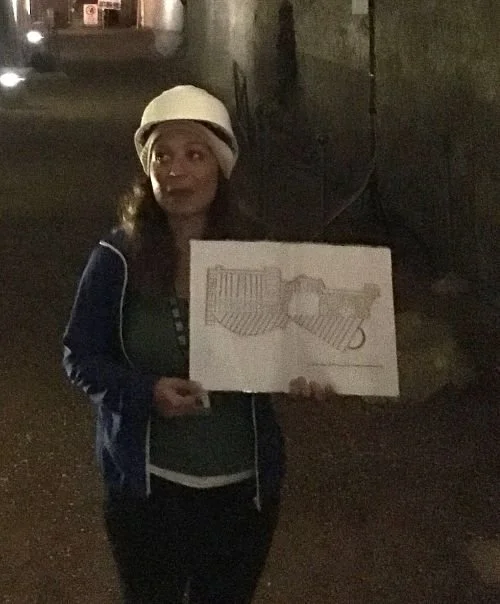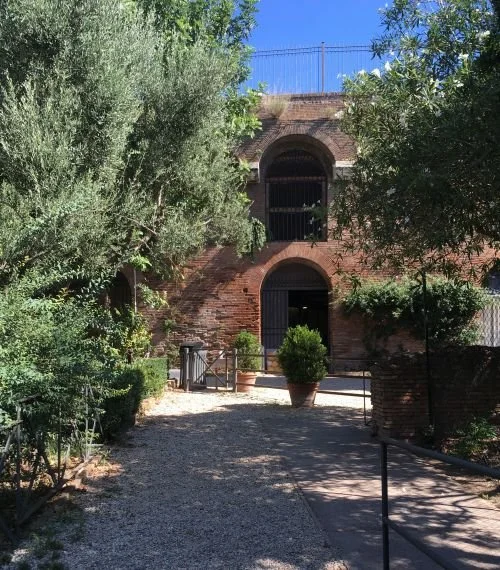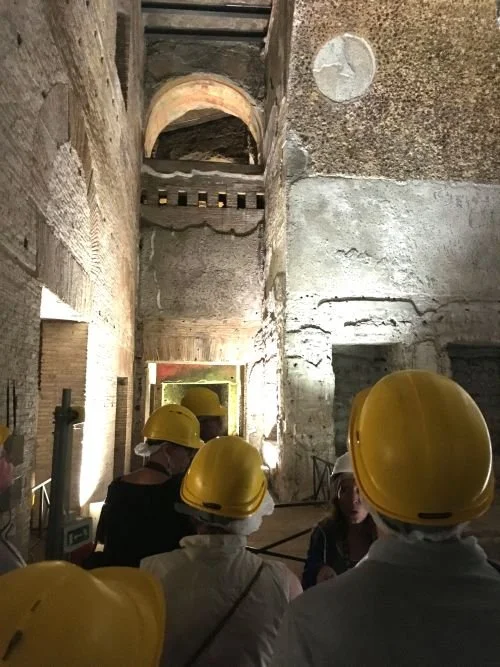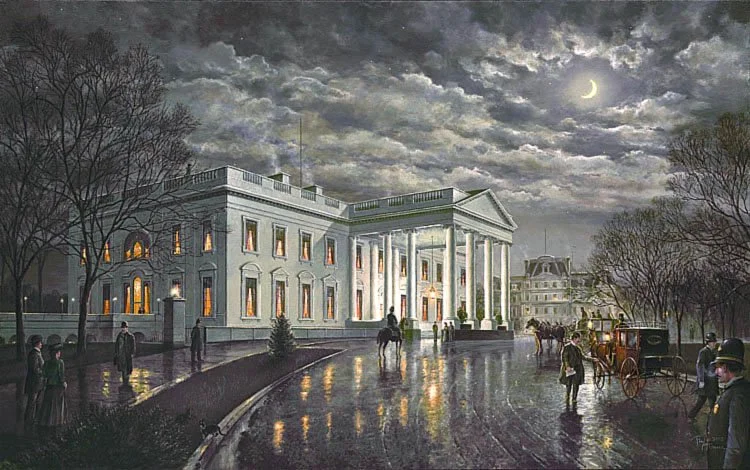An angry mob of betrayed Trump supporters attack the White House Ballroom in the artificial intelligence-generated video “MAGA Ballroom 2028.”
Aug. 11, 2025 by David Silverberg
On July 31, President Donald Trump announced that he had ordered the building of a new $200 million ballroom onto the White House.
The official announcement stated that Trump was “solving” the problem of too little White House event space and the ballroom was “much-needed.” It would be “exquisite,” “ornately designed” and “carefully crafted,” according to the announcement.
He also stated that the ballroom would be paid for by private donations.
The proposed White House ballroom as conceived by the architect, viewed from above. The new ballroom is at the center, connected to the existing White House (on the right) by a columned patio or corridor. (Art: McCrery Architects)
The proposed White House ballroom as conceived by the architect, viewed from the southwest. The new ballroom is the square addition on the right. (Art: McCrery Architects)
The interior conception of the proposed White House ballroom. (Art: McCrery Architects)
The ballroom is hardly the first physical change Trump has made to the White House. He had the famous Rose Garden paved over to create a plantless patio.
Before and after photos of the Rose Garden.
He’s festooned the Oval Office and the rest of the building with the garish gold ornamentation for which he is known.
Gold flourishes on the walls and ceiling of the Oval Office.
President Donald Trump walks through an Oval Office door with gold decorations he had installed.
Trump’s building and gilding of the White House is reminiscent of another potentate who extravagantly built an elaborate domicile—and who had gold as his dominant decorating scheme.
The Gold House
A profile of Nero on a Roman gold coin called an “aureas.” (Photo: American Numismatic Society)
Nero Claudius Caesar Augustus Germanicus is better known to the world as Nero, and is one of the most infamous Roman emperors for his madness, extravagance, unpredictable and arbitrary rule and extreme and indiscriminate cruelty. He served as Rome’s leading politician and decisionmaker from the years 54 to 68 of the Common Era.
Starting in 64 Nero built a palace for himself named the Domus Aurea in Latin, or Golden House in English. It was constructed on land burned by the Great Fire of 64 that leveled enormous portions of Rome—and which many critics suspected Nero had ordered set in order to clear the space.
Nero thought he was invincible and untouchable. He murdered or forced the suicide of the most distinguished and able Roman politicians and statesmen and replaced them with his own sycophants and toadies. As the historian Suetonius put it: “Transported and puffed up with such successes, as he considered them, he boasted that no princeps had ever known what power he really had… .”
Nero wanted to surpass the Hellenistic palaces of overseas kingdoms and he had a grandiose, malignantly narcissistic sense of himself, so he built to impress. The land for the Gold House is estimated by some scholars to have covered a massive 300 acres in the heart of Rome. It had 150 large and small rooms and a footprint of 16,000 square meters (over 172,000 square feet, about the equivalent of three football fields). Some rooms had ceilings 12 feet high, all of them decorated and embellished with gold and jewels, with one, a circular dining room, that had ceiling panels that could be opened to shower flower petals and perfume on diners as they revolved around Nero in the center like the sun.
A tour guide in the remains of the Gold House displays a schematic of its plans. (Photo: Author)
An overhead visualization of the complete Gold House and grounds. (Art: JR Casals)
Not one to keep his light under a bushel, Nero commissioned a 120-foot high statue of himself to stand at the entrance (the Statue of Liberty is 305 feet high).
Visualization of the Colossus of Nero with other buildings of the time, for scale.
He also had an immense, artificial lake built surrounded by miniature cities and landscapes of fields, farmlands, vineyards and forests populated with every sort of animal.
After a mere four years, the house was completed in 68. When Nero dedicated it, he remarked, “Good! Now I can at last begin to live like a human being.”
Nero didn’t have much time to enjoy his power or his monster mansion because that same year, faced with his misrule, extreme taxation, public discontent, provincial uprisings and mutinies by discontented generals, even the otherwise subservient and bullied Senate revolted and declared him an enemy of Rome. Now the target of all Romans, after trying to escape the city he chose to die by his own hand.
The Gold House was a huge embarrassment to all subsequent Roman emperors, who did what they could to obliterate it—and did so by overbuilding it with structures that the entire Roman public could enjoy.
On the giant lake the emperor Vespasian ordered the building of the Flavian Amphitheater, or what is today called the Colosseum. Other emperors like Titus and Trajan built huge public baths.
Nero himself was subject to a “hostis iudicatio,” a posthumous trial for treason, and he was subject to the Roman practice of “damnatio memoriae,” the damnation of his memory. His name was erased from monuments and records and his statues removed or defaced. While his giant colossus remained standing, its head was replaced with a representation of the sun god Sol Invictus.
Today there’s barely any hint of the Gold House. Tourists enter it through an otherwise obscure entrance in a hillside. Tours are underground but visitors can get a sense of its vastness in the dimly lit corridors and chambers.
The modern entrance to the Gold House. (Photo: Author)
During the tour visitors and guides wear hardhats in the enormous rooms. (Photo: Author)
The Golden House is an object lesson that excess and insanity may ultimately bring about a reckoning that topples both the ruler and the buildings he constructs.
The White House
“The White House by Moonlight,” a depiction of the White House circa 1905. (Art: Paul McGehee)
The American Executive Mansion—it wasn’t formally called the White House until 1901—while hardly a hovel, was a relatively modest presidential home for its time and so it has remained since it was first occupied in 1800.
When designed it was intended to reflect republican simplicity and virtue in contrast to the grandiose monarchical palaces of Europe. It was also intended to convey the dignity and stability of the American executive and inspire respect rather than awe. Its classical proportions and symmetry symbolized the rationality and enlightenment of the American government itself.
The design was selected in a 9-way competition. Thomas Jefferson entered anonymously but lost out to Irish-born immigrant architect James Hoban.
While the White House has been renovated many times—including a complete gutting and structural rebuilding between 1949 and 1951—the renovations were always made with respect for the building’s history, significance and the intentions of its founders, which included George Washington.
One of the most notable renewals was overseen by first lady Jaqueline Kennedy, who unveiled her efforts to the world in a television tour on Valentine’s Day, 1962. She’d overseen an interior redesign that reflected the building’s past and its historic meaning, enhancing its elegance and stature, brought back significant objects, invited widespread public participation and drew on the knowledge of experts and historians.
By contrast, Trump’s changes, including his announced ballroom, have been unilateral, secret and one might say, dictatorial. Given his almost total lack of historical perspective, knowledge or interest, they pay no respect to the building’s past or its meaning.
When Trump announced his ballroom, he had already selected McCrery Architects as designer, Clark Construction for the building and AECOM for the engineering. There were no public requests for proposals, design competitions, competitive bids, transparent selections or publicly accessible contracts. (Given Trump’s past record of non-payment, one hopes for the contractors’ sake that they’re getting their cash up front!)
As a result, the mockery began almost immediately.
(Art: M.Wuerker/Politico)
(Art: Randy Bish)
An AI image mocking the Trump ballroom. (Art: AI/anonymous)
(Art: Michael de Adder)
It has also sparked resentment, as have his other changes. Nowhere was this more clearly expressed than in an AI-generated video titled “MAGA Ballroom 2028,” created by Ari Kuschnir, a digital consultant and founder of the company “m ss ng p eces.”
This 1-minute, 45-second video depicts angry, resentful MAGA supporters suffering while Trump and his Cabinet members feast in the new ballroom. The people ultimately revolt and attack the building the same way the Trump-incited rioters attacked the Capitol Building on Jan. 6, 2021.
Windows shatter inside the Trump ballroom as rioters attack it in the AI video “MAGA Ballroom 2028.”
While “MAGA Ballroom 2028” may appear extreme and emotional, it’s a good reminder that leaders, like Nero, who behave erratically, spend extravagantly and flaunt their imperiousness in the form of ostentatious, egotistical buildings, may ultimately face a very nasty comeuppance at the hands of the people they seek to dominate.
To read a detailed account of Nero and the Great Fire of Rome, click the button below.
Liberty lives in light
© 2025 by David Silverberg


















